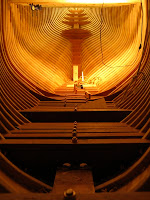 before it is launched. However, pouring whiskey on a plank of the hull of a ship is a bit more unknown.
before it is launched. However, pouring whiskey on a plank of the hull of a ship is a bit more unknown.In December, the shutter plank, or whiskey plank was installed on the CHEROKEE, the Sparkman and Stevens six-meter yacht being build by Boothbay Harbor Shipyard as an exhibit, at the Museum of Yachting.
 Why a celebration for this plank? A whiskey or shutter plank is the last plank, which needs to be put in place to finish a ship's hull. The Shutter Plank Party is an old tradition. Sometimes a glass of the last captain’s favorite drink is poured
Why a celebration for this plank? A whiskey or shutter plank is the last plank, which needs to be put in place to finish a ship's hull. The Shutter Plank Party is an old tradition. Sometimes a glass of the last captain’s favorite drink is poured  on the plank. However, the drink of the last captain of the original CHEROKEE is unknown so they used whiskey.
on the plank. However, the drink of the last captain of the original CHEROKEE is unknown so they used whiskey.After a whiskey plank is put on, the hull can be treated, sealed, and painted, and work begins on the inner fixtures of the ship. Because this marks a turning point in the construction, it is traditional to take a brief moment to celebrate the mounting of this special plank. Often, this tradition involves shots of whiskey for all.
 Although the CHEROKEE is still far from finished, once the shutter or whiskey plank is installed, a major milestone in the construction has been reached.
Although the CHEROKEE is still far from finished, once the shutter or whiskey plank is installed, a major milestone in the construction has been reached.It has been a while since we have checked in on the progress of
 the CHEROKEE, from the lofting to the completed hull. A larger view of these images can be view here.
the CHEROKEE, from the lofting to the completed hull. A larger view of these images can be view here.If you would like to see more great pictures and read more details of this project click into the CHEROKEE Blog by Tom Daniels.













































